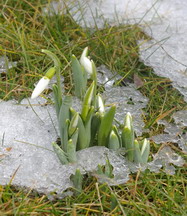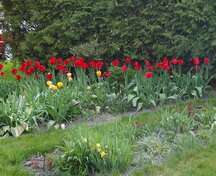|
Fall Planted Flower Bulbs
|
Information for the complete novice: many of the most delightful spring flowers, Crocus, Tulips, Daffodils and a host of others grow from bulbs that you plant in the autumn.

Why Plant Them?
I personally seem to plant way too many flower bulbs each fall but when they show up in the spring, I always change my opinion. Fall planted / spring flowering bulbs are probably one of the best values in the garden. They are easy to plant. We plant them in the fall when gardeners are not as busy. They last for several years. They provide very early spring flowers when we desperately need something blooming to chase away the winter. They are not expensive. Most Tulip bulbs will cost less than a dollar and will bloom for several years. Daffodils, (Narcissus)(pictured right,) will cost just under 2 dollars a bulb and will form a larger clump every year and will continue to flourish for many years. I have some clumps that are well over 10 years old and still getting bigger and better each year.

Why Are Some Bulbs Cheaper?
In bulbs as in many things you usually get what you pay for. Flower bulbs are graded for size by the growers and sold according to that grade. If you find a bag of bulbs in a discount store that appear to be much cheaper than in your garden centre, look on the package for the indication of the bulb’s size. It is usually expressed in cm as the diameter of the bulbs. For instance, in Tulips (pictured left,) the largest size is usually 12+ which indicates that the bulbs are all at least 12 cm in diameter. The larger the bulb the bigger the flower that it will produce. The other factor in the pricing of bulbs is the variety. As in many types of plants, the newer varieties will cost more in their early years. Unless you are becoming addicted to flower bulbs, (not that I would understand that phenomenon,) there are many very excellent bulb varieties of each type that have been around for a while that will produce an excellent show in your garden. Some such as the Pheasant’s Eye Narcissus have been in cultivation since the 1600's and are still worth growing.

How Do I Choose?
As in any garden planning, choose what you like. Then choose a few that are new to you. The secret to a great spring garden is to choose a variety of different flower bulbs that bloom at different times in order to have as long a spring flowering season as possible. Even among one class, like the Tulips, there is a wide range of flowering times. The earliest bulbs, usually the Snowdrops, Galanthus nivalis cv. (pictured right,) will literally bloom at the edge of the receding snow. That’s usually some time in early March in my part of the world. There then follows a succession of the other small bulbs. This is followed by the main show of Tulips and Narcissus and the season continues well into early summer with some of the Allium varieties. In fact there are even some autumn flowering types that poke up and bloom (banner at top of the page,) through the blanket of coloured leaves decorating your garden. Do be careful if you start planning a spring bulb garden. If you choose a few types because you think the colours and sizes will go well together, make sure that they also bloom at the same time or the desired effect will be lost.
 How Do I Plant Them?
How Do I Plant Them?
Pointy side up is the silly, but accurate, answer. Although they grow just fine no matter which side is up; you just make their life a little easier by following the pointy rule. There are two ways to distribute them in the garden. Both work well. Plant them in clumps of several bulbs that make a real statement when they bloom. If you are only planting a few then this is the most effective method. I also like to plant larger quantities by spacing them evenly over a larger area of my gardens (see picture on left,) so that the whole bed bursts with bright red tulips. In a perennial garden, the other perennials will grow up between them. In an annual flower bed you can tuck the new annuals evenly in between the bulbs and you get a transition from a bed of Tulips to a bed of Marigolds. As they are going to be there for a few years they need to be planted relatively deeply, 10 - 20 cm (4"- 8"). The general rule being: the larger the bulb, the deeper you plant them.
A weekend of pleasant autumn gardening can yield over 3 months of spring garden delight. Plant bulbs and lots of them.
You can search my entire site for answers to your other gardening mysteries.
Dallying In The Dirt
Regular Tips and Smiles from Ken’s Gardening Activities
return from Flower Bulbs to Ken's home page
